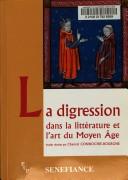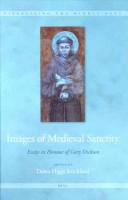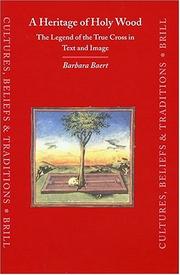| Listing 1 - 10 of 11 | << page >> |
Sort by
|
Periodical
ISSN: 03501361 24060755 Year: 1966 Publisher: Beograd : Galerija fresaka
Abstract | Keywords | Export | Availability | Bookmark
 Loading...
Loading...Choose an application
- Reference Manager
- EndNote
- RefWorks (Direct export to RefWorks)
Art, Medieval --- Art médiéval --- Periodicals --- Périodiques --- Kunst. --- Art, Medieval. --- Art médiéval --- Périodiques --- DOAJ-E EPUB-ALPHA-Z EPUB-PER-FT --- Medieval art --- medieval art

ISSN: 03391752 ISBN: 2853995976 2821836120 9782853995979 Year: 2005 Volume: 51
Abstract | Keywords | Export | Availability | Bookmark
 Loading...
Loading...Choose an application
- Reference Manager
- EndNote
- RefWorks (Direct export to RefWorks)
Ce volume réunit les 31 contributions des Actes du colloque du CUER MA (2004). Étudier la digression dans la littérature médiévale constituait une sorte de défi. Il ne s'agissait ni de condamner ces excursus ni d'en faire l'éloge. Qui, de l'auteur ou du lecteur, est le plus apte à borner l'espace digressif et à l'apprécier ? Dans les précautions que les auteurs prennent à commenter ou à justifier leur écart, se prononcent les fonctions différentes, mais non exclusives l'une de l'autre, qu'il est censé remplir. La digression se présente comme utile ; qu'elle cherche à amuser, à séduire, à conseiller, à renseigner, à engager à l'action, ou à faire participer le lecteur à l'acte d'écriture, elle relève toujours d'une stratégie. Du XIIe au XVe siècle, son emploi témoigne d'une volonté sommative, avouée, voire revendiquée, dans les encyclopédies, les traités didactiques, les récits de voyages, les chroniques, plus masquée dans les œuvres de fiction, où son usage permet paradoxalement à nombre d'auteurs de renforcer la cohésion d'une matière narrative sujette aux égarements du plaisir de raconter. Lecteurs en quête de sens, nous montrons comme nous sommes portés à découvrir sous l'abondance des mots et le déplacement des points de vue un ordre de la pensée. Quant à l'usage médiéval de la digression, il témoigne d'une littérature qui cherche à définir sa fonction dans la société, son utilité, son pouvoir, qui laisse voir comment elle s'enracine dans une tradition qu'elle ne cesse de renouveler. (www.fabula.org)
Old French literature --- Thematology --- Aesthetics of art --- Digression (Rhetoric) --- Literature, Medieval --- Art, Medieval --- Digression (Rhétorique) --- Littérature médiévale --- Art médiéval --- Fiction --- French literature --- Technique. --- History and criticism. --- Languages & Literatures --- Literature - General --- Digression (Rhétorique) --- Littérature médiévale --- Art médiéval --- Mediaeval literature and art --- Criticism --- Fiction - Technique. --- French literature - To 1500 - History and criticism. --- littérature médiévale --- digression --- excursus
Book
ISBN: 3050094923 3050094915 3050060964 1306206693 9783050060965 9783050094915 Year: 2013 Publisher: Berlin : Akademie Verlag,
Abstract | Keywords | Export | Availability | Bookmark
 Loading...
Loading...Choose an application
- Reference Manager
- EndNote
- RefWorks (Direct export to RefWorks)
Die Erinnerung an das Reich der mittelalterlichen Könige und Kaiser nahm in der nationalsozialistischen Geschichts- und Kulturpolitik eine herausragende Stellung ein. Das Reich Karls des Großen und die Jahrhunderte der "deutschen Kaiserzeit", die Zeit der Ottonen, Salier und Staufer, galten als erste Phase "deutscher Größe" und als Vorwegnahme und historische Rechtfertigung des von den Nationalsozialisten angestrebten "großgermanischen Reiches". Von dieser völkisch-nationalistischen Deutung des Mittelalters, deren Wurzeln bis ins 19. Jahrhundert zurückreichen, blieb auch die Sicht auf die mittelalterliche Kunst nicht unbeeinflusst. Im Mittelalter wurde der Anfang "deutscher Kunst" gesucht, in der mittelalterlichen Kunst sah man einen frühen Ausdruck des deutschen Nationalcharakters, und entsprechend konnte sie sowohl als Vorbild für eine neu zu schaffende, nationale und "volksverbundene" Kunst in Anspruch genommen als auch gegen die "Entartungen" der modernen Kunst ins Feld geführt werden. Im Zentrum der Publikation steht die Praxis der Mittelalter-Kunstgeschichte im Nationalsozialismus, ihre Vorgeschichte und unmittelbare Folge. Es geht um eine Analyse der Gegenstände, Begriffe, Methoden und Deutungsmuster, mit denen mediävistische Kunstgeschichte im Nationalsozialismus operierte. Ein zweiter Themenschwerpunkt liegt auf der Popularisierung des Mittelalterbildes in Schrifttum, Film und Veranstaltungen.
National socialism and intellectuals. --- National socialism and science. --- National socialism and art --- Art, Medieval --- Middle Ages in popular culture --- Political Science --- Visual Arts --- Art, Architecture & Applied Arts --- Law, Politics & Government --- Socialism, Communism & Anarchism --- Visual Arts - General --- Socialism and art. --- Art, Medieval. --- Nazisme et art --- Art médiéval --- Moyen Age dans la culture populaire --- Congresses --- Congrès --- Medieval art --- Art and socialism --- Art
Periodical
ISSN: 21693099 0016920X Year: 1963 Publisher: Chicago ; London New York University of Chicago Press International Center of Medieval Art
Abstract | Keywords | Export | Availability | Bookmark
 Loading...
Loading...Choose an application
- Reference Manager
- EndNote
- RefWorks (Direct export to RefWorks)
Gesta presents original research on developments in the study of art and life of the Middle Ages. The journal embraces all facets of artistic production from ca. 300 to ca. 1500 C.E., in Europe, the Mediterranean region, and the Slavic world. The journal has twice been awarded the annual Van Courtlandt Elliott Prize of the Medieval Academy of America for a “first article in medieval studies judged…to be of outstanding quality.”
Art, Romanesque --- Architecture, Romanesque --- Architecture romane. --- Art médiéval. --- Art roman. --- JEX16 --- Romanesque architecture --- Romanesque art --- Architecture, Medieval --- Art, Medieval --- Christian art and symbolism --- Architecture, Romanesque. --- Art, Romanesque. --- Medieval --- Art --- Art medieval --- Arquitectura medieval --- Història --- Edat mitjana --- Arqueologia medieval --- Civilització medieval --- Art visual --- Arts visuals --- Belles arts --- Iconografia --- Civilització --- Estètica

ISBN: 9789004160538 9004160531 9786611936051 1281936057 9047420683 9789047420682 9789047420682 9781281936059 661193605X Year: 2007 Volume: v. 1 Publisher: Leiden : Brill,
Abstract | Keywords | Export | Availability | Bookmark
 Loading...
Loading...Choose an application
- Reference Manager
- EndNote
- RefWorks (Direct export to RefWorks)
Assembled on the occasion of Gary Dickson's retirement from the University of Edinburgh following a distinguished career as an internationally acclaimed scholar of medieval social and religious history, this volume contains contributions by both established and newer scholars inspired by Dickson’s particular interests in medieval popular religion, including ‘religious enthusiasm’. Together, the essays comprise a comprehensive and rich investigation of the idea of sanctity and its many medieval manifestations across time (fifth through fifteenth centuries) and in different geographical locations (England, Scotland, France, Italy, the Low Countries). By approaching the theme of sanctity from multiple disciplinary perspectives, this highly original collection pushes forward current academic thinking about medieval hagiography, iconography, social history, women's studies, and architectural history.
Christian special devotions --- anno 500-1499 --- France --- Scotland --- Belgium --- Netherlands --- Italy --- England --- 75.046.3 --- 246 "04/14" --- 75.046.3 Religie in de schilderkunst. Heiligenbeelden --- Religie in de schilderkunst. Heiligenbeelden --- Christelijke kunst en symbolisme--Middeleeuwen --- Christian art and symbolism --- Holiness --- Civilization, Medieval --- Art, Medieval --- Art et symbolisme chrétiens --- Sainteté --- Civilisation médiévale --- Art médiéval --- Congresses. --- Congrès --- Europe --- Church history --- Religious life and customs --- Histoire religieuse --- Vie religieuse --- Council of Europe countries --- Eastern Hemisphere --- Eurasia --- Dickson, Gary

ISBN: 9004139443 9786610915392 9047405749 1280915390 1429454725 9789004139442 9781429454728 9789047405740 Year: 2004 Volume: 22 Publisher: Leiden; Boston : BRILL,
Abstract | Keywords | Export | Availability | Bookmark
 Loading...
Loading...Choose an application
- Reference Manager
- EndNote
- RefWorks (Direct export to RefWorks)
In the fourth century the idea arose that the Cross on which Christ was crucified had been found by Helena, mother of Emperor Constantine. Thus began a legend that would grow and flourish throughout the Middle Ages and cause the diffusion of countless splinters of holy wood. And where there is wood, there was once a tree. Could it be that the Cross was made from that most noble species, the Tree of Life? So, gathering characters along the way, the legend evolved into a tale that stretches from the Creation to the End of Time. A Heritage of Holy Wood is the first reconstruction of the iconographic and literary tradition of the Legend of the True Cross. Its broad scope encompasses relic cults, pilgrimages, travellers' tales and the Tree of Life and involves Church Fathers, crusader kings, Teutonic Knights and mendicant orders, all of which influenced the legend's depiction from its earliest representation in manuscripts, reliquaries and altarpieces, to the great monumental cycles of the high Middle Ages. If the holy wood was the medium of medieval memory, A Heritage of Holy Wood reveals the growth rings of fifteen centuries of imagery.
Holy Cross --- Art, Byzantine. --- Art, Medieval. --- Legends --- Art [Byzantine ] --- Art [Medieval ] --- Art byzantin --- Art médiéval --- Byzantijnse kunst --- Byzantine art --- Kunst [Byzantijnse ] --- Kunst [Middeleeuwse ] --- Medieval art --- Middeleeuwse kunst --- Iconography --- Christian church history --- Christian special devotions --- anno 500-1499 --- 091.31:7.04 --- 246 --- Academic collection --- 091.31:7.04 Verluchte handschriften: iconografie --- Verluchte handschriften: iconografie --- Christelijke kunst en symbolisme --- Religion Art in Christianity --- Art, Byzantine --- Art, Medieval --- Sainte Croix --- Art médiéval --- Art --- Légendes --- Christian art and symbolism --- Cross --- Feast of the Cross --- Art. --- Holy Cross - Legends - Art.
Book
ISBN: 9789004185555 9004185550 9789004228276 9004228276 9789004228283 9004228284 9786613665201 9004228322 1280688262 9789004297531 9004297537 9789004228320 Year: 2012 Volume: 7 Publisher: Boston : Brill,
Abstract | Keywords | Export | Availability | Bookmark
 Loading...
Loading...Choose an application
- Reference Manager
- EndNote
- RefWorks (Direct export to RefWorks)
These volumes propose a renewed way of framing the debate around the history of medieval art and architecture to highlight the multiple roles played by women. Today’s standard division of artist from patron is not seen in medieval inscriptions—on paintings, metalwork, embroideries, or buildings—where the most common verb is 'made' ( fecit ). At times this denotes the individual whose hands produced the work, but it can equally refer to the person whose donation made the undertaking possible. Here twenty-four scholars examine secular and religious art from across medieval Europe to demonstrate that a range of studies is of interest not just for a particular time and place but because, from this range, overall conclusions can be drawn for the question of medieval art history as a whole. Contributors are Mickey Abel, Glaire D. Anderson, Jane L. Carroll, Nicola Coldstream, María Elena Díez Jorge, Jaroslav Folda, Alexandra Gajewski, Loveday Lewes Gee, Melissa R. Katz, Katrin Kogman-Appel, Pierre Alain Mariaux, Therese Martin, Eileen McKiernan González, Rachel Moss, Jenifer Ní Ghrádaigh, Felipe Pereda, Annie Renoux, Ana Maria S. A. Rodrigues, Jane Tibbetts Schulenburg, Stefanie Seeberg, Miriam Shadis, Ellen Shortell, Loretta Vandi, and Nancy L. Wicker.
Art --- Sociology of the family. Sociology of sexuality --- anno 500-1499 --- Art, Medieval. --- Architecture, Medieval. --- Women artists --- Women art patrons --- Art and society --- Architecture and society --- Architecture --- Architecture and sociology --- Society and architecture --- Sociology and architecture --- Art and sociology --- Society and art --- Sociology and art --- Art patrons --- Women benefactors --- Artists, Women --- Women as artists --- Artists --- Middle Ages --- Medieval art --- History --- Social aspects --- Human factors --- Art médiéval --- Architecture médiévale --- Femmes artistes --- Femmes mécènes --- Art et société --- Architecture et société --- Histoire --- Architecture, Medieval --- Art, Medieval
Book
ISBN: 9780300219166 0300219164 9780300228496 030022849X 0300247761 9780300247763 Year: 2017 Publisher: New Haven
Abstract | Keywords | Export | Availability | Bookmark
 Loading...
Loading...Choose an application
- Reference Manager
- EndNote
- RefWorks (Direct export to RefWorks)
"In the rapidly changing world of the early Middle Ages, depictions of the cosmos represented a consistent point of reference across the three dominant states-the Frankish, Byzantine, and Islamic Empires. As these empires diverged from their Greco-Roman roots between 700 and 1000 A.D. and established distinctive medieval artistic traditions, cosmic imagery created a web of visual continuity, though local meanings of these images varied greatly. Benjamin Anderson uses thrones, tables, mantles, frescoes, and manuscripts to show how cosmological motifs informed relationships between individuals, especially the ruling elite, and communities, demonstrating how domestic and global politics informed the production and reception of these depictions. The first book to consider such imagery across the dramatically diverse cultures of Western Europe, Byzantium, and the Islamic Middle East, [it] illuminates the distinctions between the cosmological art of these three cultural spheres, and reasserts the centrality of astronomical imagery to the study of art history"--Jacket flap.
Art, Medieval --- Cosmology in art --- Art médiéval --- Cosmologie dans l'art --- European influences --- Byzantine influences. --- Islamic influences --- Themes, motives. --- Influence européenne --- Influence byzantine --- Influence islamique --- Thèmes, motifs --- 912 <09> "04/14" --- 091:52 --- 52 <092> --- 52 <092> Astronomie. Astrofysica. Ruimteonderzoek. Geodesie--Biografieën --- 52 <092> Astronomy. Astrophysics. Space research. Geodesy--Biografieën --- Astronomie. Astrofysica. Ruimteonderzoek. Geodesie--Biografieën --- Astronomy. Astrophysics. Space research. Geodesy--Biografieën --- 091:52 Handschriften i.v.m. astronomie-- Zie ook: {091:133.52} --- Handschriften i.v.m. astronomie-- Zie ook: {091:133.52} --- 912 <09> "04/14" Cartografie. Kaarten. Plattegronden. Atlassen--Geschiedenis van ...--Middeleeuwen --- 912 <09> "04/14" Cartography. Maps. Atlasses--Geschiedenis van ...--Middeleeuwen --- Cartografie. Kaarten. Plattegronden. Atlassen--Geschiedenis van ...--Middeleeuwen --- Cartography. Maps. Atlasses--Geschiedenis van ...--Middeleeuwen --- Weltall (Motiv). --- Kunst. --- Astronomie (Motiv). --- Geschichte 500-1100. --- Art médiéval --- Influence européenne --- Thèmes, motifs --- ART / History / Medieval. --- Islamic civilization --- Medieval art --- European influences. --- Islamic influences.
Book
ISBN: 0691032122 0691000379 9780691032122 Year: 1993 Volume: 2 Publisher: Princeton (N.J.) Princeton university press
Abstract | Keywords | Export | Availability | Bookmark
 Loading...
Loading...Choose an application
- Reference Manager
- EndNote
- RefWorks (Direct export to RefWorks)
History --- iconology --- iconography --- Princeton, Index of Christian Art --- Art --- congres / 1990 --- -Art, Medieval --- -Iconografie --- Iconografie van de schilderkunst. Iconologie. Onderwerpen voor de schilderkunst --- Kunstgeschiedenis ; Middeleeuwen --- Kunstgeschiedenis ; Renaissance. Barok. Rococo --- 75.04 Iconografie van de schilderkunst. Iconologie. Onderwerpen voor de schilderkunst --- Art, Byzantine --- Art, Medieval --- Art, Renaissance --- Christian art and symbolism --- 7.033 --- 7.034 --- Iconografie --- Middeleeuwen --- Renaissance --- 246.5 --- 75.04 --- 246.5 Emblematiek. Iconologie. Christelijke iconografie. Dodendans --- Emblematiek. Iconologie. Christelijke iconografie. Dodendans --- Renaissance art --- Byzantine art --- Congresses --- Christian spirituality --- Iconography --- anno 500-1499 --- -Art, Renaissance --- Congresses. --- Art byzantin --- Art médiéval --- Art de la Renaissance --- Art et symbolisme chrétiens --- Congrès --- Art, Byzantine - Congresses --- Art, Medieval - Congresses --- Christian art and symbolism - - Medieval, 500-1500 - - Alps --- Art, Renaissance - Congresses --- Christelijke kunst
Book
ISBN: 9789004243699 9789004245815 9004243690 9004245812 9781299276789 1299276784 Year: 2013 Volume: 9 Publisher: Leiden Brill
Abstract | Keywords | Export | Availability | Bookmark
 Loading...
Loading...Choose an application
- Reference Manager
- EndNote
- RefWorks (Direct export to RefWorks)
In Imago Mortis: Mediating Images of Death in Late Medieval Culture , Ashby Kinch argues for the affirmative quality of late medieval death art and literature, providing a new, interdisciplinary approach to a well-known body of material. He demonstrates the surprising and effective ways that late medieval artists appropriated images of death and dying as a means to affirm their artistic, social, and political identities. The book dedicates each of its three sections to a pairing of a visual convention (deathbed scenes, the Three Living and Three Dead, and the Dance of Death) and a Middle English literary text (Hoccleve’s Lerne for to die , Audelay’s Three Dead Kings , and Lydgate’s Dance of Death ).
Thematology --- Iconography --- anno 500-1499 --- Death in art. --- Death in literature. --- Art, Medieval. --- Literature, Medieval --- Visual communication --- Middle Ages. --- Death --- Mort dans l'art --- Mort dans la littérature --- Art médiéval --- Littérature médiévale --- Communication visuelle --- Moyen Age --- Mort --- History and criticism. --- History --- Social aspects --- Histoire et critique --- Histoire --- Aspect social --- Europe --- Intellectual life. --- Social conditions --- Vie intellectuelle --- Conditions sociales --- 393 --- 091.31:7.04 --- 7.045 --- Dood. Dodengebruiken. Dodenritueel. Lijkverbranding. Begrafenis. Crematie. Rouw. Opbaren. Lijkstoet. Sterven. Dodenmaskers --- Verluchte handschriften: iconografie --- Iconografie: allegorieen; symbolen; dodendansen; emblemata --- Totentanz --- Künste --- Kunst --- Literatur --- Art. --- Death. --- Literature. --- Literature, Medieval. --- Social history. --- Visual communication. --- Social aspects. --- To 1500. --- Europe. --- Art, Medieval -- History. --- Death -- Social aspects -- Europe -- History -- To 1500. --- Europe -- Intellectual life. --- Europe -- Social conditions -- To 1492. --- Literature, Medieval -- History and criticism. --- Visual communication -- Europe -- History -- To 1500. --- Death in art --- Death in literature --- Art, Medieval --- Middle Ages --- Visual Arts --- Art, Architecture & Applied Arts --- Visual Arts - General --- History and criticism --- Totentanz. --- Künste. --- Kunst. --- Literatur. --- 7.045 Iconografie: allegorieen; symbolen; dodendansen; emblemata --- 091.31:7.04 Verluchte handschriften: iconografie --- 393 Dood. Dodengebruiken. Dodenritueel. Lijkverbranding. Begrafenis. Crematie. Rouw. Opbaren. Lijkstoet. Sterven. Dodenmaskers --- Mort dans la littérature --- Art médiéval --- Littérature médiévale --- Graphic communication --- Imaginal communication --- Pictorial communication --- Communication --- Dark Ages --- History, Medieval --- Medieval history --- Medieval period --- World history, Medieval --- World history --- Civilization, Medieval --- Medievalism --- Renaissance --- Dying --- End of life --- Life --- Terminal care --- Terminally ill --- Thanatology --- Medieval art --- Philosophy --- 393 Death. Treatment of corpses. Funerals. Death rites --- Death. Treatment of corpses. Funerals. Death rites --- History.
| Listing 1 - 10 of 11 | << page >> |
Sort by
|

 Search
Search Feedback
Feedback About
About Help
Help News
News